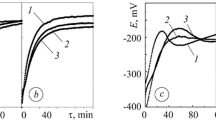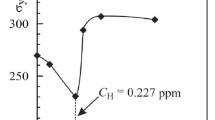The susceptibility to hydrogen-assisted cracking of cold-drawn pearlitic steel wires used as reinforcement in concrete is studied in alkaline media modeling pore liquids in concrete. The prestressing steel is established to become susceptible to hydrogen embrittlement under potentials of – 1.1 V (SCE). The maximum fracture load, as well as the elongation to fracture, decrease as the cathodic potential increases; the effect is more noticeable for slow strain rates. The fracture mechanism in aggressive media differs from the fracture mechanism in air. The role of surface defects in the environment-assisted cracking is discussed.





Similar content being viewed by others
References
M. Siegwart, Risk Analysis of Hydrogen Induced Stress Corrosion Cracking of Prestressed Concrete: Identification of Critical Parameters, University of Ulster (2004).
F. González, G. Fajardo, G. Arliguie, C. A. Juarez, and G. Escadeillas, “Electrochemical realkalization of carbonated concrete: an alternative approach to prevention of reinforcing steel corrosion,” in: F. González, G. Fajardo, G. Arliguie, C. A. Juarez, and G. Escadeillas, Int. J. Electrochem. Sci., 6, 6332–6349 (2011).
J. Toribio and A. M. Lancha, “Effect of cold drawing on susceptibility to hydrogen embrittlement of prestressing steel,” Mat. Struct., 26, 30–37 (1993).
J. Toribio and M. Elices, “Influence of residual stresses on hydrogen embrittlement susceptibility of prestressing steels,” Int. J. Solids and Struct., 28, 791–803 (1991).
R. N. Parkins, M. Elices, V. Sanchez-Galvez, et al., “Environment sensitive cracking of prestressing steels,” Corr. Sci., 22, No. 5, 379–405 (1982).
M. A. Olivare, A. Valient, and J. C. Gálvez, “Estudio estadístico de los defectos en el alambre de pretensado y su relacion con el ensayo FIP,” Anales de Mecánica de la Fractura, 20, 213–218 (2003).
M. I. Hredil and J. Toribio, “Corrosion resistance of prestressing steel wires,” Fiz.-Khim. Mekh. Mater., 50, No. 5, 39–43 (2014); English translation: Mater. Sci., 50, No. 5, 665–670 (2105).
J.-S. Kim, Y.-H. Lee, D.-L. Lee, K.-T. Park, and Ch.-S. Lee, “Microstructural influences on hydrogen delayed fracture of highstrength steels,” Mat. Sci. Eng. A., 505, 105–110 (2009).
J. Toribio, J-C. Matos, and B. González, “Role of surface defects in the initiation of fatigue cracks in pearlitic steel,” in: Proc. Internat Conf. on Fracture (ICF 13), June 16–21, 2013, Beijing, China (2013).
J. Toribio, F.-J. Ayaso, B. González, J-C. Matos, D. Vergara, and M. Lorenzo, “Tensile fracture behavior of progressively-drawn pearlitic steels,” Metals, 6, No. 5, Paper No. 114 (2016).
O. Z. Student, A. D. Markov, and H. M. Nykyforchyn, “Specific features of the influence of hydrogen on the properties and mechanism of fracture of the metal of welded joints of steam pipelines at thermal power plants,” Fiz.-Khim. Mekh. Mater., 42, No. 4, 26–35 (2006); English translation: Mater. Sci., 42, No. 4, 451–460 (2006).
Author information
Authors and Affiliations
Corresponding author
Additional information
Published in Fizyko-Khimichna Mekhanika Materialiv, Vol. 52, No. 5, pp. 61–65, September–October, 2016.
Rights and permissions
About this article
Cite this article
Hredil, М.І., Toribio, J. Susceptibility of Prestressing Steel Wires to Hydrogen-Assisted Cracking in Alkaline Media Simulating Concrete Pore Solutions. Mater Sci 52, 669–674 (2017). https://doi.org/10.1007/s11003-017-0007-9
Received:
Published:
Issue Date:
DOI: https://doi.org/10.1007/s11003-017-0007-9




